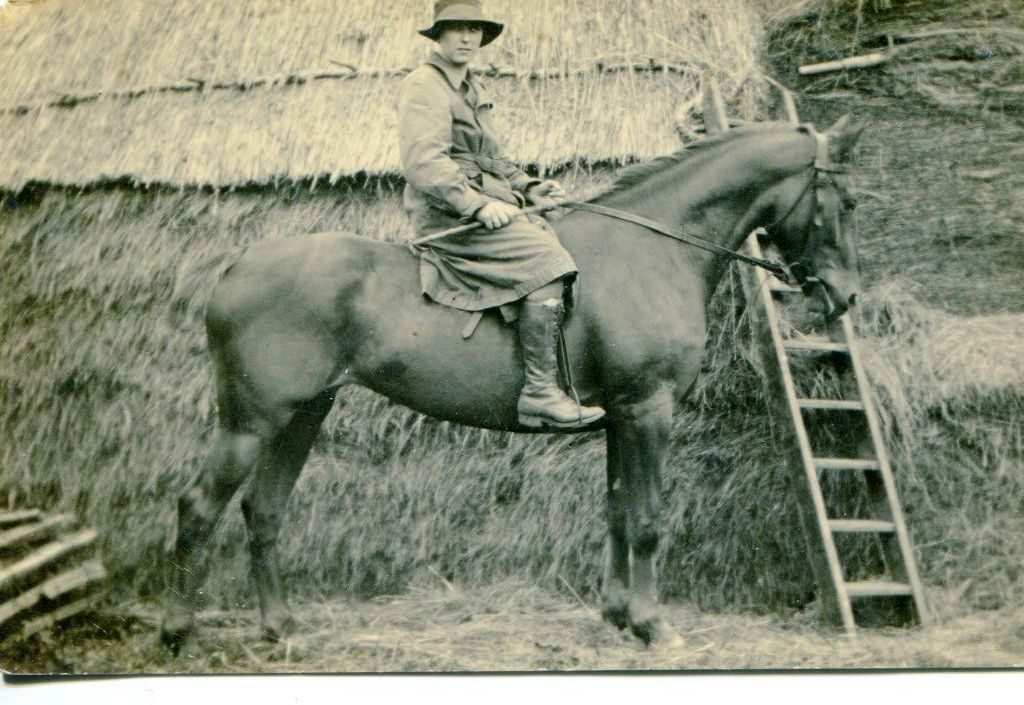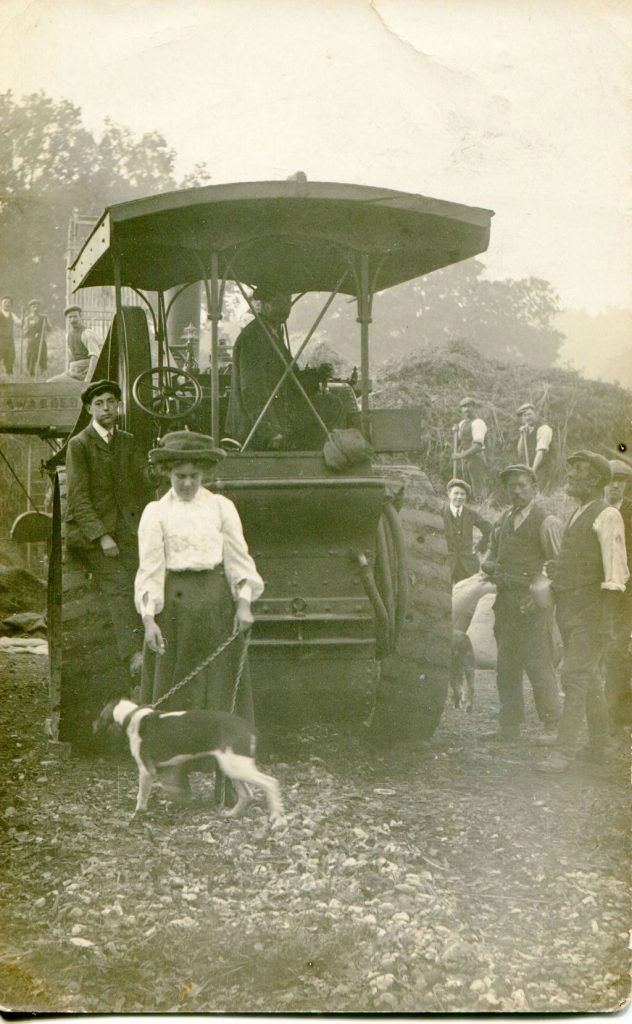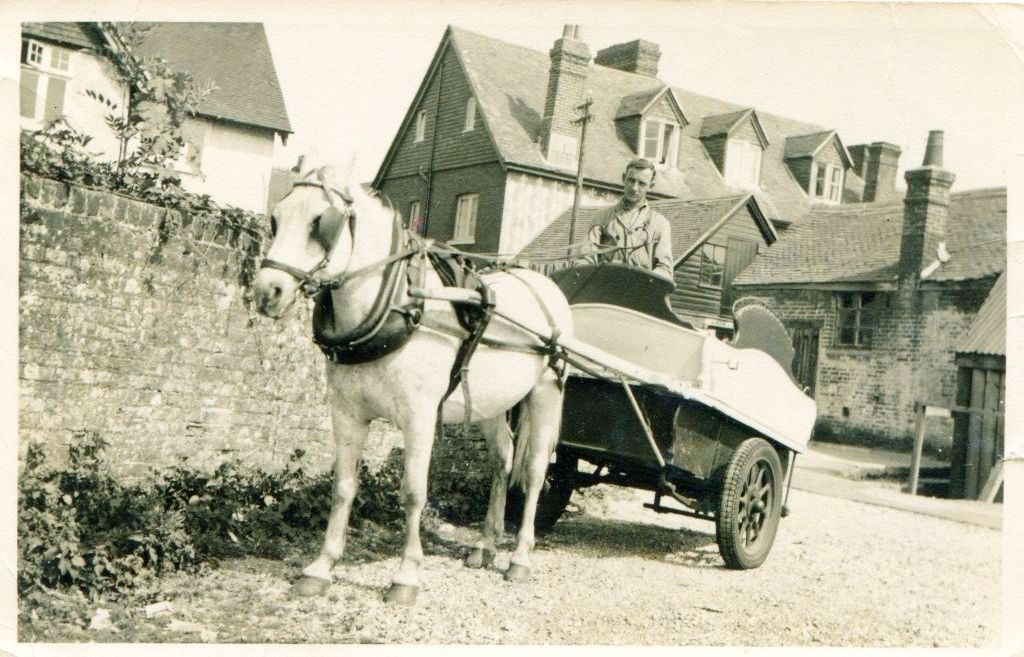Caroline Stride, Transcript 1, Part 4
Images: Caroline Stride, copyright reserved. For any rights requests, please contact the New Forest Heritage Centre in the first instance.
Caroline Stride Trans 1 Part 4 Duration: 5:47
(CS006)

Caroline: Now this lady, I only knew her as Auntie Glad. I don’t think there was any blood relationship with the Penny family, but she was a great friend of Richard’s nan who was Agnes Penny, Agnes Zebedee before she got married. And she stayed very, very friendly with Agnes, Nanny Penny, all through their married life.
CB: She’s got a hayrick behind her –
Caroline: She has. And I think that’s great ‘cos you see the hayrick closely; over the top of the ladder you see the hay knife actually stuck in the side there.
CB: Yeah.
Caroline: And how they used to cut the hay out. Yeah, in its day, you know, it was – it would have been a smart rick.
CB: Did you have a thatcher within the family?
Caroline: Grandad Penny, George Henry… no, actually, I think it was Charlie Penny, so it was Charles Penny, he was a thatcher and his family – there were ten boys and two girls – the boys would’ve got all the hay in and made it into a rick and he was the one who did the thatching. So he would be perched up on the top after the rick had been built and shaping it up and putting the thatch on.
CB: Lovely. Number seven. (CS007)

Caroline: This is a picture up in the rick yard, I always wondered where the rick yard was here at Blackwater, but it was just part of the yard away from the entrance and as far as I know these steam threshing machines would come round, they would visit farms in the area, trundle about from one place to the other, thrashing the corn out of the corn crop and this, actually, on the picture I think I actually counted twelve people so think how labour intensive all this activity was. But the lady in the foreground is Aunt Kate, now she was Charlie Penny’s sister and she spent a lot of time here, she didn’t get married and she was up and close to forty, or if not forty, and a lot of the pictures you will find Aunt Kate posing there somewhere.
CB: Okay –
Caroline: But that’s part of it, she’s a very photogenic woman, I thought; but in the background you can actually see George Henry Penny here to the side with his hat cocked off to the side and I think the chap there with his hands on his hips in the background, I think that is perhaps young Charlie Penny.
CB: Okay –
Caroline: I think this picture is probably in the Edwardian time, so we’re probably talking um 1910? Roughly around that time, and, yeah, what an event it must have been; you can see some sacks of corn there kept to the side. And so, it’s a fascinating picture.
CB: Yeah, I’ve got a very similar picture from [information redacted] and [information redacted] worked for [information redacted], and that’s –
Caroline: Yes –
CB: That’s what he did.
Caroline: Yeah –
CB: They were contractors so it’s obviously the same.
Caroline: Yeah, but, you know, there would’ve been people like this going round down the south of the Forest or would’ve been the [information redacted]. Sadly, I don’t know who this contractor is, I don’t know if anyone else would –
CB: Okay.
Caroline: – would know that, but there you go.
CB: Okay. Let’s have a look at the next one, number eight (CS008)

Caroline: Now this was Edward Penny, Ted Penny, who was the last Penny farmer here at Blackwater. He was one of Charles Penny’s sons; as I’ve said already he had ten boys, he was one of the boys and he carried on after Charlie Penny died at the farm here at Blackwater. This is on the milk float and he would have been delivering milk in the High Street. This is directly behind the old, er, Workmen’s Club in Lyndhurst, in the car park.
CB: Really –
Caroline: Before there was any development of the Car Park. The car park just used to be a green field.
CB: Yeah.
Caroline: But this is the exit, this, here – behind the car. That is the exit going out, so this building here would be where the Workmen’s Club is.
CB: Oh, I see.
Caroline: Yeah. So that was in probably, I think, in the early nineteen fifties.
CB: Okay. Yeah, that’s lovely.
(CS009)

Caroline: And again, this is Edward Penny – Teddy as he’s known, Ted Penny and he was again delivering milk, we think in the Custards. You can see he’s got his arm on the churn.
CB: Oh, it’s a big one, this time.
Caroline: A big churn, yeah. Yeah. And the cows were – originally, they were hand-milked here at Blackwater by the dairymaids, members of the family again and then it was whoever was about to take the milk cart out and deliver milk, so anyone could’ve got roped in –
CB: Yeah.
Caroline: – to go round with the milk float.

